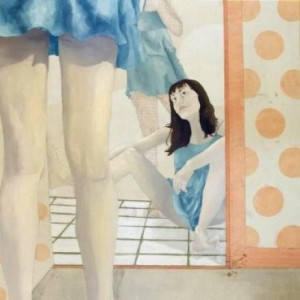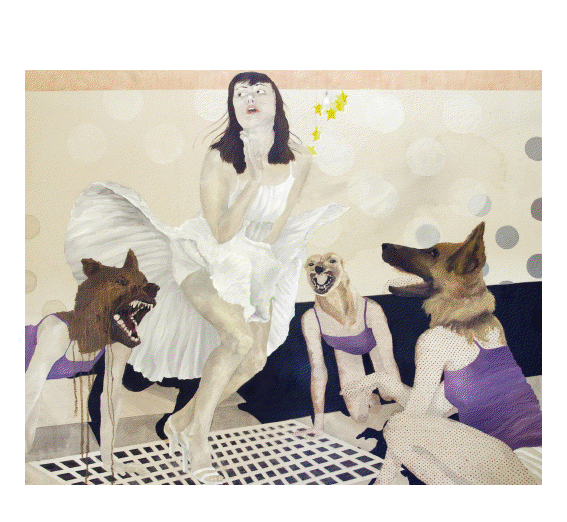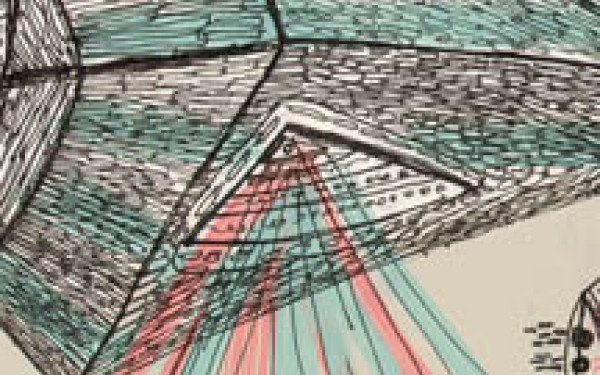Surveyed by Wolves
Aggression & Sexuality in Oil on Canvas
It’s around dinner time and Café Aux Deux Marie on St. Denis is practically empty when Marianne Pon-Layus comes in for our interview. Born and raised in Montreal, the UQAM student is splitting her time between painting and teaching arts in an elementary after-school program. She just finished her master in Visual and Medias Arts, which culminated with the opening of her exhibit Scènes de Genre, at the Lilian Rodriguez Gallery at Le Belgo.
Light skin, dark hair, and not one ounce of exuberance, she sits down in front of me. The first few minutes before our interview remind me strangely of a few blind dates I had in the past, nervous laughs and awkward silences included. We are both, for very different reasons, seemingly nervous. Pon-Layus ‘s work is both unsettling and deeply meditative, and I’m eager to discuss the foundations of these controversial images with her.
Scènes de Genre is 11 paintings that immediately demand attention, where violence, innocence, sexuality and pop culture mix together in a surreal and perverse manner. Pon-Layus includes herself prominently in all her paintings. She explains it’s her way of having only one feminine figure who takes on a multitude of roles.
Being so intrinsically involved in her own work, it certainly makes the audience wonder what exactly it is that she’s implying about herself.
“It’s certain that it’s me who poses, it’s me who takes pictures of myself for the paintings,” she says. “So, I play along fully and I have fun playing with this bad girl image, pushing the limits and be a little more unsettling.”
She adds that she’s not so much trying to communicate something from her personal life, as she is attempting to make a commentary. “There’s a lot of how women are represented in our culture, how social relationship are represented. It’s often a problem. If you take Hollywood films, there has to be something happening, a physical confrontation, so I play with those key elements.”
Pon-Layus credits artists like Ghada Amer and Su-en Wong, both playing with graphic sexual content, as the impetus for the exhibit. Photographer Cindy Sherman is also mentioned as Pon-Layus ‘s early introduction to the concept of gender roles and identities in arts.
Her imagination blossoms mostly from fairy tales, where characters often experience transformation, as well as historical paintings that often portray scenes of war, rape and extreme violence. She also talks about this manual of good manners from the ’40s as an initiating element for her creative thinking in Scènes de Genre.
“Its images were so clean that for my work, it was also ironic, and I just felt like doing something a little crazy to those images of women dressed up to the nines,” she said.

Sipping on her espresso, Pon-Layus explains to me that, on a more daily basis, she takes a lot of her ideas from movies, often reenacting scenes she gets a certain vibe from. For one of her paintings not featured in her exhibit impersonates the boxer Rocky, doing the same pose, in the same clothes – except that it’s her in that pose, stressing again the recurring concept of skewing gender roles.
One of the most interesting paintings from the exhibit explores social relationship and jealousy between women. Le Dangeureux Supplement features Pon-Layus reconstructing the iconic scene from The Seven-Year Itch, where Marilyn Monroe is holding down her white dress. In Pon-Layus ‘s painting, she is circled by a group of half-naked women with wolf heads standing on all fours. She finds that by incorporating animal characteristics within her paintings, aggression is more easily read and acknowledged by the audience.
“It is kind of the problem with painting,” she calmly observes, “every time I want to demonstrate aggression or violence, there’s always the problem of staticity […] there’s always the problem that it’s cold and that [spectators] don’t feel engaged enough, or attacked. And so the dog is a strategy to try to extend a little bit from what is expected – and that it ends up having this aggressive effect, as a final result.”
“My goal is really not to turn on the spectators,” she adds. “But it’s still a game. […] Yes, the people are showing a little skin. Yes, it’s seductive. We can agree on that, but because of the composition, I would like people to feel a little bad for having these feelings.”
She also stresses the importance of contrast and irony in her paintings, and how she wishes her audience to feel ambiguous when looking at her work.
“I want it there to be attraction-repulsion in the mix. It comes down also to making images as pretty as possible, but again very violent. This need to get closer to the canvas, but at the same time, the disgust for what is being represented.”
Scènes de Genre will be on display at the Lilian Rodriguez Gallery (372, rue Sainte-Catherine Ouest) until February 25. more info


_600_832_s.png)


1_600_375_90_s_c1.jpg)
21_600_375_90_s_c1.jpg)
